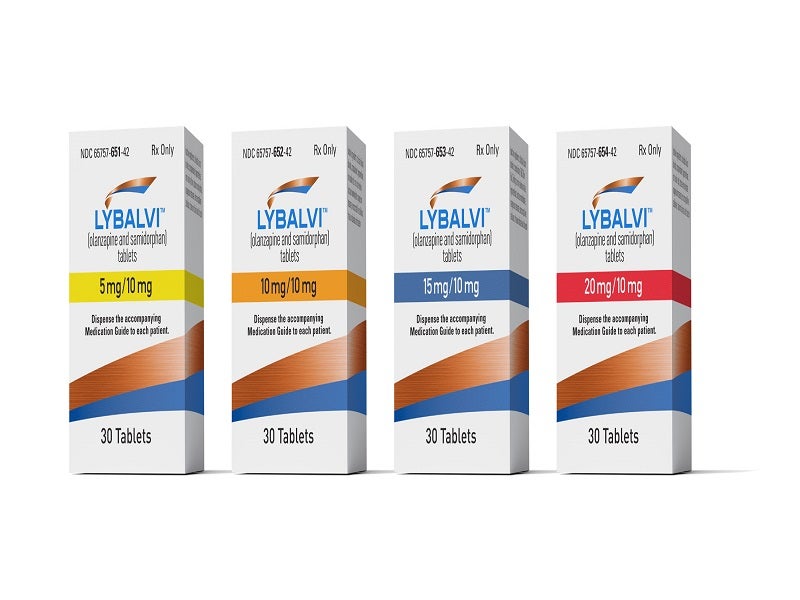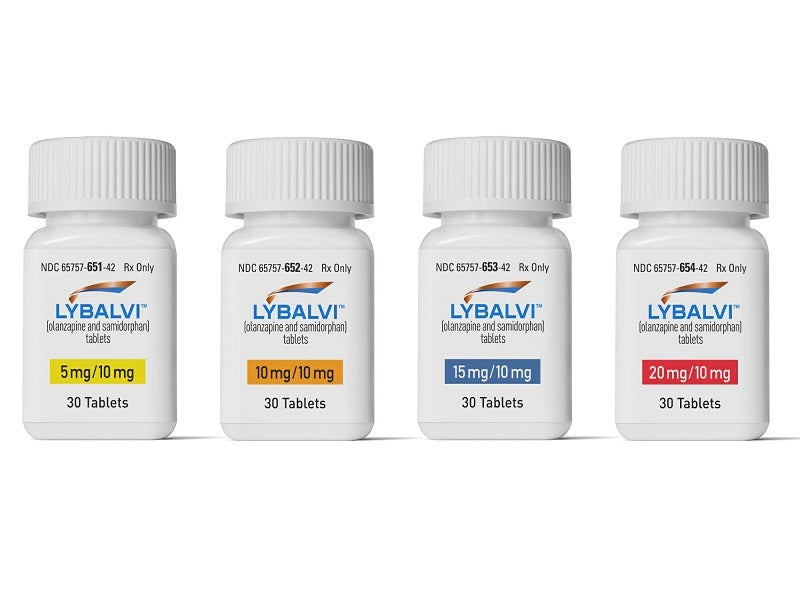Lybalvi® (olanzapine and samidorphan) is an oral atypical antipsychotic drug indicated for the treatment of adults with schizophrenia and bipolar I disorder.
The drug is used as a maintenance monotherapy or for the acute treatment of manic or mixed episodes, either as a monotherapy or as an adjunctive therapy with lithium or valproate.
Developed by biopharmaceutical company Alkermes, Lybalvi is available as film-coated, bilayer tablets containing 10mg of samidorphan and 5mg, 10mg, 15mg or 20mg of olanzapine.
Regulatory approvals for Lybalvi
In November 2019, Alkermes submitted a new drug application (NDA) for Lybalvi (ALKS 3831) to the US Food and Drug Administration (FDA) for the treatment of schizophrenia and bipolar I disorder. The NDA was accepted for regulatory review in January 2020.
The company received a complete response letter (CRL) from the FDA in November 2020 related to the review of manufacturing records of Alkermes’ manufacturing facility in Wilmington, Ohio.
The FDA imposed certain conditions related to the tablet coating process at the facility. In response to the FDA’s CRL, Alkermes resubmitted its NDA for Lybalvi, which was accepted for review in December 2020.
The FDA approved Lybalvi for the treatment of schizophrenia and bipolar I disorder in June 2021. The drug has been commercially available by prescription in the US since October 2021.
Schizophrenia and bipolar I disorder causes and symptoms
Schizophrenia is a severe neurological condition characterised by symptoms such as hallucinations and delusions, disordered speech and thoughts, agitated or repetitive movements, as well as depression, suppressed emotions and social withdrawal.
The condition causes psychosis and is linked to various functional impairments affecting several aspects of a person’s personal, family, social, educational and occupational functioning. Schizophrenia is estimated to affect around 1.1% of the US population.
Bipolar disorder is a brain disease characterised by severe fluctuations in a person’s mood, energy and capacity to work.
Patients suffering from bipolar I disorder may experience severe mood swings, ranging from excessive highs (mania) to extreme lows (depression). The disease is associated with the occurrence of at least one manic episode, with or without a severe depressive episode, and affects around 1% of adults in the US each year.
Lybalvi’s mechanism of action
Lybalvi is a combination of olanzapine, an established atypical antipsychotic, and samidorphan, an opioid antagonist.
The mechanism of action of olanzapine is unknown, although its efficacy in the treatment of schizophrenia or bipolar I disorder may be mediated by a combination of dopamine and serotonin type 2 (5HT2) antagonism.
Samidorphan’s mechanism of action may be mediated through opioid receptor antagonism.
Clinical trials on Lybalvi
The FDA’s approval of Lybalvi was based on the results of the ENLIGHTEN clinical development programme, which consisted of the ENLIGHTEN-1 and ENLIGHTEN-2 studies in people living with schizophrenia or bipolar I disorder.
In the ENLIGHTEN-1 study, Lybalvi’s antipsychotic efficacy, safety and tolerability were assessed and compared to placebo for four weeks in 403 patients experiencing an acute exacerbation of schizophrenia.
The study met its primary endpoint, with Lybalvi achieving statistically significant decreases in positive and negative syndrome scale (PANSS) levels from baseline when compared to placebo. The study also included an olanzapine comparative arm, in which the drug showed comparable improvements from baseline PANSS scores against placebo.
In the ENLIGHTEN-2 study, Lybalvi’s weight gain profile was evaluated over the course of six months in 561 patients with stable schizophrenia.
The study achieved its co-primary outcomes of a lower mean percentage weight gain from baseline at six months compared with the olanzapine group, as well as a lower proportion of patients who gained 10% or more of their baseline body weight compared to placebo.
The ENLIGHTEN programme also included supporting studies that assessed the drug’s pharmacokinetic and metabolic properties and its long-term safety, in addition to pharmacokinetic bridging studies that compared the drug with Zyprexa® (olanzapine).
The most common adverse events reported in both the Lybalvi and olanzapine treatment groups were weight gain, somnolence, increased appetite, and dry mouth.






